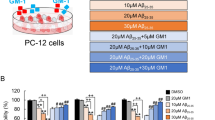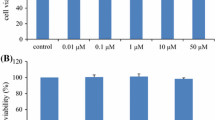Abstract
Ganglioside GM1 was shown to increase the viability of PC12 cells exposed to hydrogen peroxide or amyloid β-peptide (Aβ25–35). The PC12 cells transfected with mutant gene (expressing APPSW) were found to be more sensitive to oxidative stress than the cells transfected with wild type gene (expressing APPWT) or vector-transfected cells, GM1 being effective in enhancing the viability of the cells transfected with mutant gene. The exposure to hydrogen peroxide or Aβ25–35 results in a partial inactivation of Na+,K+-ATPase in PC12 cells, H2O2 increases MDA accumulation in these cells. But these effects could be partially prevented or practically abolished by GM1 ganglioside. In the presence of the inhibitor of tyrosine kinase of Trk receptors (K-252a) the protective and metabolic effects of GM1 on PC12 cells in conditions of oxidative stress caused by hydrogen peroxide are not observed or are markedly diminished.







Similar content being viewed by others
References
Fighera MR, Bonini JS, de Oliveira TG et al (2003) GM1 ganglioside attenuates convulsions and thiobarbituric acid reactive substances production induced by intrastriatal injection of methylmalonic acid. Int J Biochem Cell Biol 35:465–473
Choi JS, Kim JA, Joo CK (2003) Activation of MAPK and CREB by GM1 induces survival of RGCs in the retina with axotomized nerve. Invest Ophthalmol Vis Sci 44:1747–1752
Bachis A, Mocchetti I (2006) Semisynthetic sphingoglycolipid LIGA20 is neuroprotective against human immunodeficiency virus-gp120-mediated apoptosis. J Neurosci Res 83:890–896
Hadjiconstantinou M, Neff NH (1998) GM1 ganglioside: in vivo and in vitro trophic actions on central neurotransmitter systems. J Neurochem 70:1335–1345
Avrova NF, Victorov IV, Tyurin VA et al (1998) Inhibition of glutamate-induced intensification of free radical reactions by gangliosides: possible role in their protective effect in rat cerebellar granule cells and brain synaptosomes. Neurochem Res 23:945–952
Mahadik SP, Bharucha VA, Stadlin A et al (1992) Loss and recovery of activities of α+ and α isozymes of (Na+,K+)-ATPase in cortical focal ischemia: GM1 ganglioside protects plasma membrane structure and function. J Neurosci Res 32:209–220
Sautter J, Hoglinger GU, Oertel WH et al (2000) Systemic treatment with GM1 ganglioside improves survival and function of cryopreserved embryonic midbrain grafted to the 6-hydroxydopamine-lesioned striatum. Exp Neurol 164:121–129
Geisler FH, Coleman WP, Grieco G et al (2001) The Sygen multicenter acute spinal cord injury study. Spine 26(Suppl 24):S87–98
Candelise L, Ciccone A (2002) Gangliosides for acute ischemic stroke. Stroke 33:2336
Becker D, Sadowsky CL, McDonald JW (2003) Restoring function after spinal cord injury. Neurologist 9:1–15
Wahlgren NG, Ahmed N (2004) Neuroprotection in cerebral ischemia: facts and fancies – the need for new approaches. Cerebrovasc Dis 17(Suppl 1):153–166
Augustinsson LE, Blennow K, Blomstrand C et al (1997) Intracerebroventricular administration of GM1 ganglioside to presenile. Alzheimer patients. Dement Geriatr Cogn Disord 8:26–33
Svennerholm L, Brane G, Karlsson I et al (2002) Alzheimer disease – effect of continuous intracerebroventricular treatment with GM1 ganglioside and a systematic activation programme. Dement Geriatr Cogn Disord 14:128–136
Matsuoka Y, Saito M, LaFrancois J et al (2003) Novel therapeutic approach for the treatment of Alzheimer’s disease by peripheral administration of agents with an affinity to beta amyloid. J Neurosci 23:29–33
Ariga T, Yu RK (1999) GM1 inhibits amyloid beta-protein-induced cytokine release. Neurochem Res 24:219–226
Kakio A, Nishimoto S, Yanagisawa K et al (2002) Interactions of amyloid beta-protein with various gangliosides in raft-like membranes: importance of GM1 ganglioside-bound form as an endogenous seed for Alzheimer amyloid. Biochemistry 41:7385–7390
Yamamoto N, Igbabvoa U, Shimada Y et al (2004) Accelerated Abeta aggregation in the presence of GM1-ganglioside-accumulated synaptosomes of aged apoE4-knock-in mouse brain. FEBS Lett 569:135–139
Mandal PK, Pettegrew JW (2004) Alzheimer’s disease: NMR studies of asialo (GM1) and trisialo (GT1b) ganglioside interactions with Aβ1–40 peptide in a membrane mimic environment. Neurochem Res 29:447–453
Vassault A (1983) Lactate dehydrogenase: UV-method with pyruvate and NADH. In: Bergmeyer HU (ed) Methods of enzymatic analysis. Verlag Chemie, Weinheim vol 3, pp 118–126
Porter NA, Nixon J, Isaac R (1976) Cyclic peroxides and the thiobarbituric assay. Biochim Biophys Acta 441:506–512
Leon A, Facci L, Toffano G et al (1981) Activation of Na+,K+-ATP-ase by nanomolar concentrations of GM1 ganglioside. J Neurochem 37:350–357
Tyurin VA, Tyurina YuYu, Avrova NF (1992) Ganglioside-dependent factor, inhibiting lipid peroxidation in rat brain synaptosomes. Neurochem Int 20:401–407
Rauvala H (1979) Monomer-micelle transition of the ganglioside GM1 and the hydrolysis by Clostridium perfringes neuraminidase. Eur J Biochem 97:555–564
Ulrich-Bott B, Wiegandt HJ (1984) Micelle properties of glycosphingolipids in aqueous media. Lipid Res 25:1233–1245
Saqr HE, Pearl DK, Yates AJ (1993) A review and predictive models of ganglioside uptake by biological membranes. J Neurochem 61:395–411
Marques C, Keil U, Bonert A et al (2003) Neurotoxic mechanisms caused by Alzheimer’s disease-linked Swedish amyloid precursor protein mutation: oxidative stress, caspases, and the JNK pathway. J Biol Chem 278:28294–28302
Ferrari G, Anderson BL, Stephen RM et al (1995) Prevention of apoptotic neuronal death by GM1 ganglioside. Involvement of Trk neurotrophin receptors. J BiolChem 270:3074–3080
Ferrari G, Greene LA (1998) Promotion of neuronal survival by GM1 ganglioside. Phenomenology and mechanism of action. Ann NY Acad Sci 845:263–273
Arcuri C, Bianchi R, Brozzi F et al (2005) S100B Increases proliferation in PC12 neuronal cells and reduces their responsiveness to nerve growth factor via Akt activation. J Biol Chem 280:4402–4414
Ferrari G, Batistatou A, Green LA (1993) Gangliosides rescue neuronal cells from death after trophic factor deprivation. J Neurosci 13(5):1879–1887
Schubert D, Kimura H, Maher P (1992) Growth factors and vitamin E modify neuronal glutamate toxicity. Proc Natl Acad Sci USA 89:8264–8267
Ochiai T, Ohno S, Soeda S et al (2004) Crocin prevents the death of rat pheochromocytoma (PC12) cells by its antioxidant effects stronger than those of alpha-tocopherol. Neurosci Lett 362:61–64
Shearman MS, Ragan CI, Iversen LL (1994) Inhibition of PC12 cell redox activity is a specific, early indicator of the mechanism of β-amyloid cell death. Proc Natl Acad Sci 91:1470–1474
Jang JH, Surh YJ (2003) Protective effect of resveratrol on β-amyloid-induced oxidative PC12 cell death. Free Radical Biol Med 24:1100–1110
Rogers J, Strohmeyer R, Kovelowski CJ et al (2002) Microglia and inflammatory mechanisms in the clearance of amyloid beta peptide. Glia 40:260–269
Eckert A, Steiner B, Marques C et al (2001) Elevated vulnerability to oxidative stress-induced cell death and activation of caspase-3 by the Swedish amyloid precursor protein mutation. J Neurosci Res 64:183–192
Avrova NF, Zakharova IO, Tyurin VA et al (2002) Different metabolic effects of ganglioside GM1 in brain synaptosomes and phagocytic cells. NeurochemRes 27:751–759
Fighera MR, Royes LF, Furian AF et al (2006) GM1 prevents seizures, Na+,K+-ATP-ase activity inhibition and oxidative stress induced by glutaric acid and pentylenetetrazole. Neurobiol Dis 22:611–623
Mark RJ, Keller JN, Kruman I et al (1997) Basic FGF attenuates amyloid beta-peptide-induced oxidative stress, mytochondrial dysfunction, and impairment of Na+,K+-ATPase activity in hippocampal neurons. Brain Res 756:205–214
Duchemin AM, Ren Q, Mo L et al (2002) GM1 ganglioside induces phosphorylation and activation of Trk and Erk in brain. J Neurochem 81:696–707
Singleton DW, Lu CL, Colella R et al (2000) Promotion of neurite outgrowth by protein kinase inhibitors and ganglioside GM1 in neuroblastoma cells involves MAP kinase ERK1/2. Int J Dev Neurosci 18:797–805
Mo L, Ren Q, Duchemin AM et al (2005) GM1 and ERK signaling in the aged brain. Brain Res 1054:125–134
Acknowledgments
We express our deep gratitude to Prof. W. Muller, Department of Pharmacology, University of Frankfurt, Germany, the Project Coodinator of NATO CLG Grant (LST 980136), who donated us transfected and naive PC12 cells.
The work was supported by grant of Russian fund for basic research No 06-04-48603 and by Colloborative Linkage Grant of NATO Science Programme (LST 980136).
Author information
Authors and Affiliations
Corresponding author
Rights and permissions
About this article
Cite this article
Sokolova, T.V., Zakharova, I.O., Furaev, V.V. et al. Neuroprotective Effect of Ganglioside GM1 on the Cytotoxic Action of Hydrogen Peroxide and Amyloid β-peptide in PC12 cells. Neurochem Res 32, 1302–1313 (2007). https://doi.org/10.1007/s11064-007-9304-2
Received:
Accepted:
Published:
Issue Date:
DOI: https://doi.org/10.1007/s11064-007-9304-2




